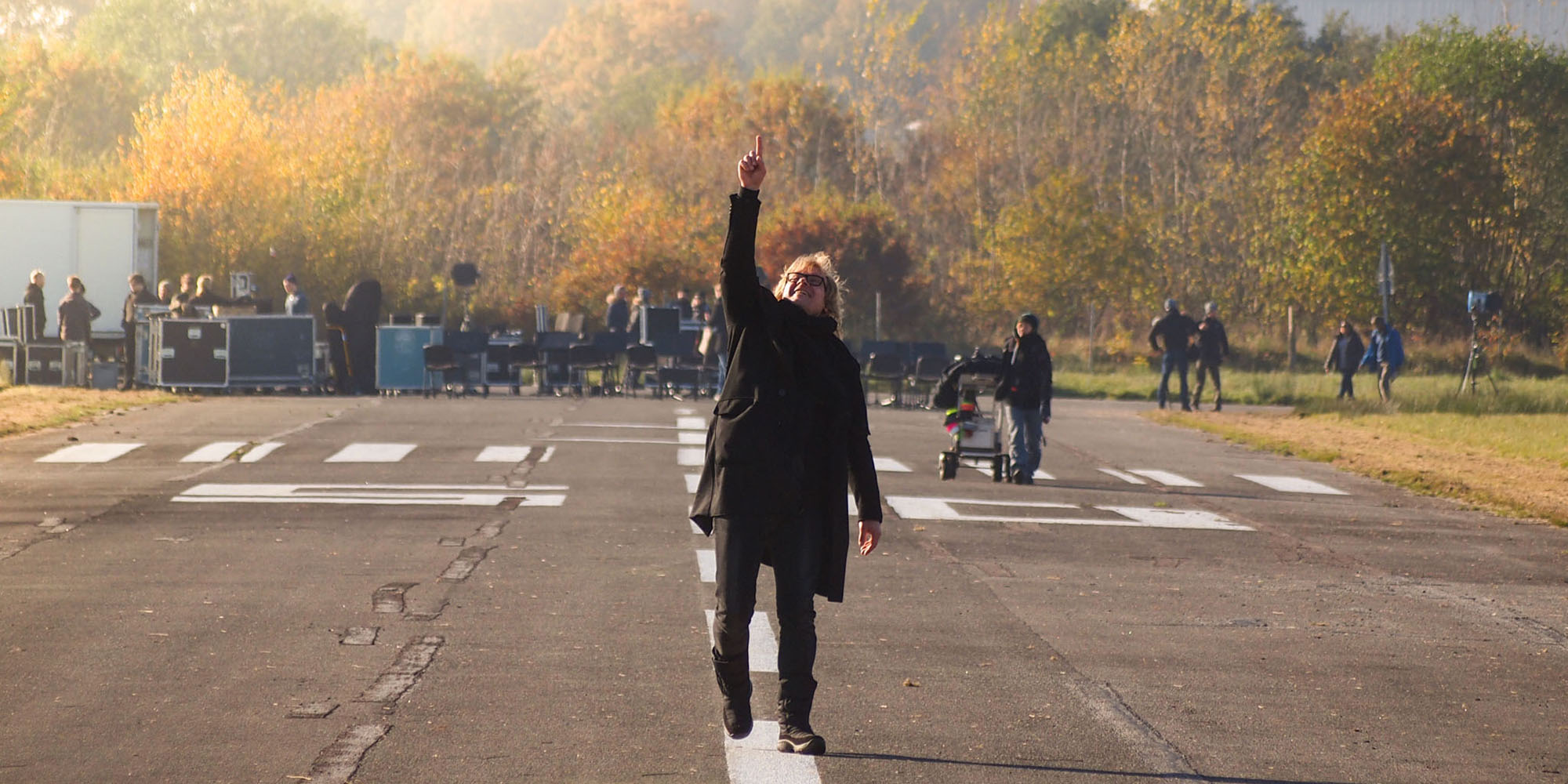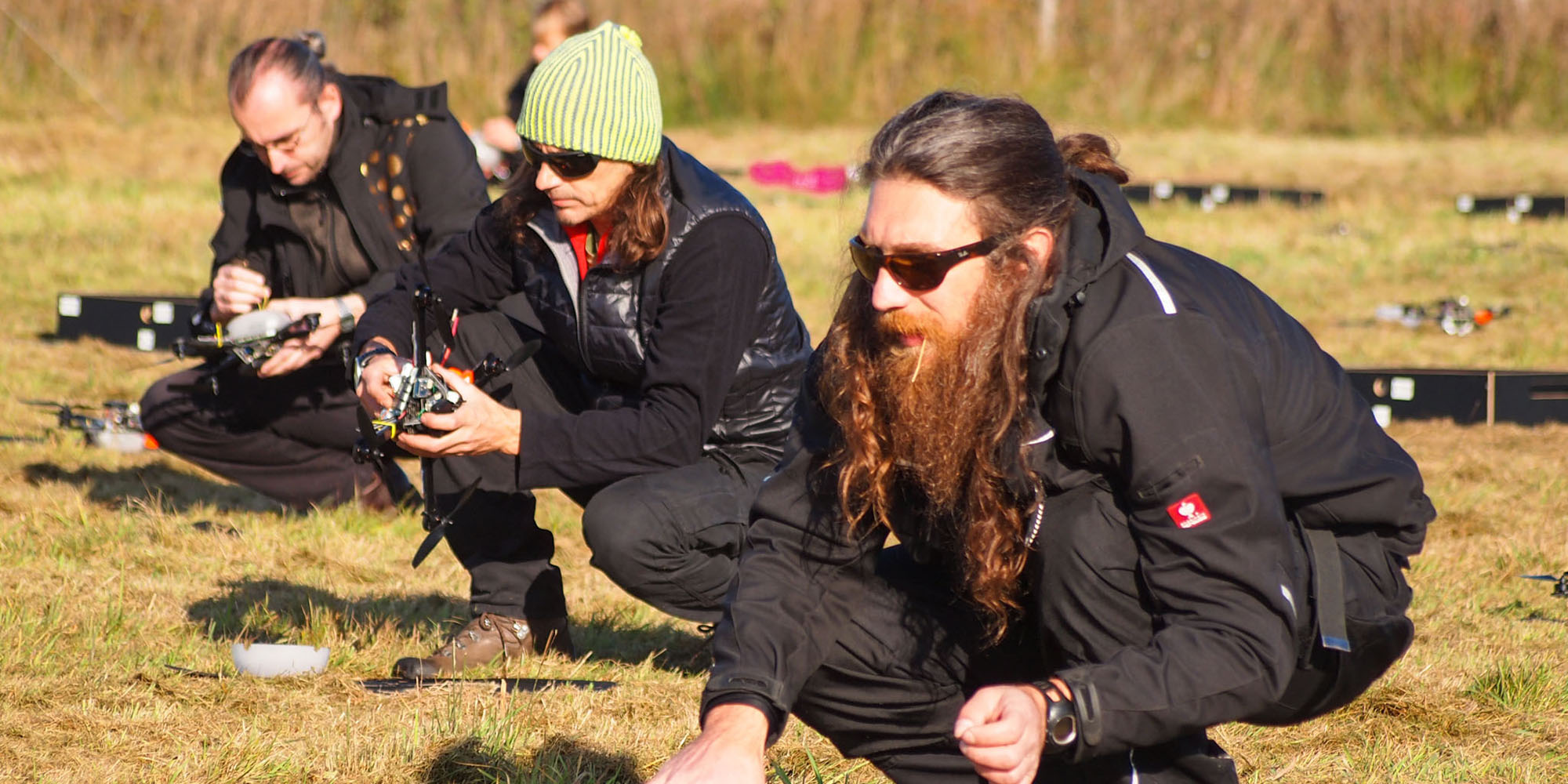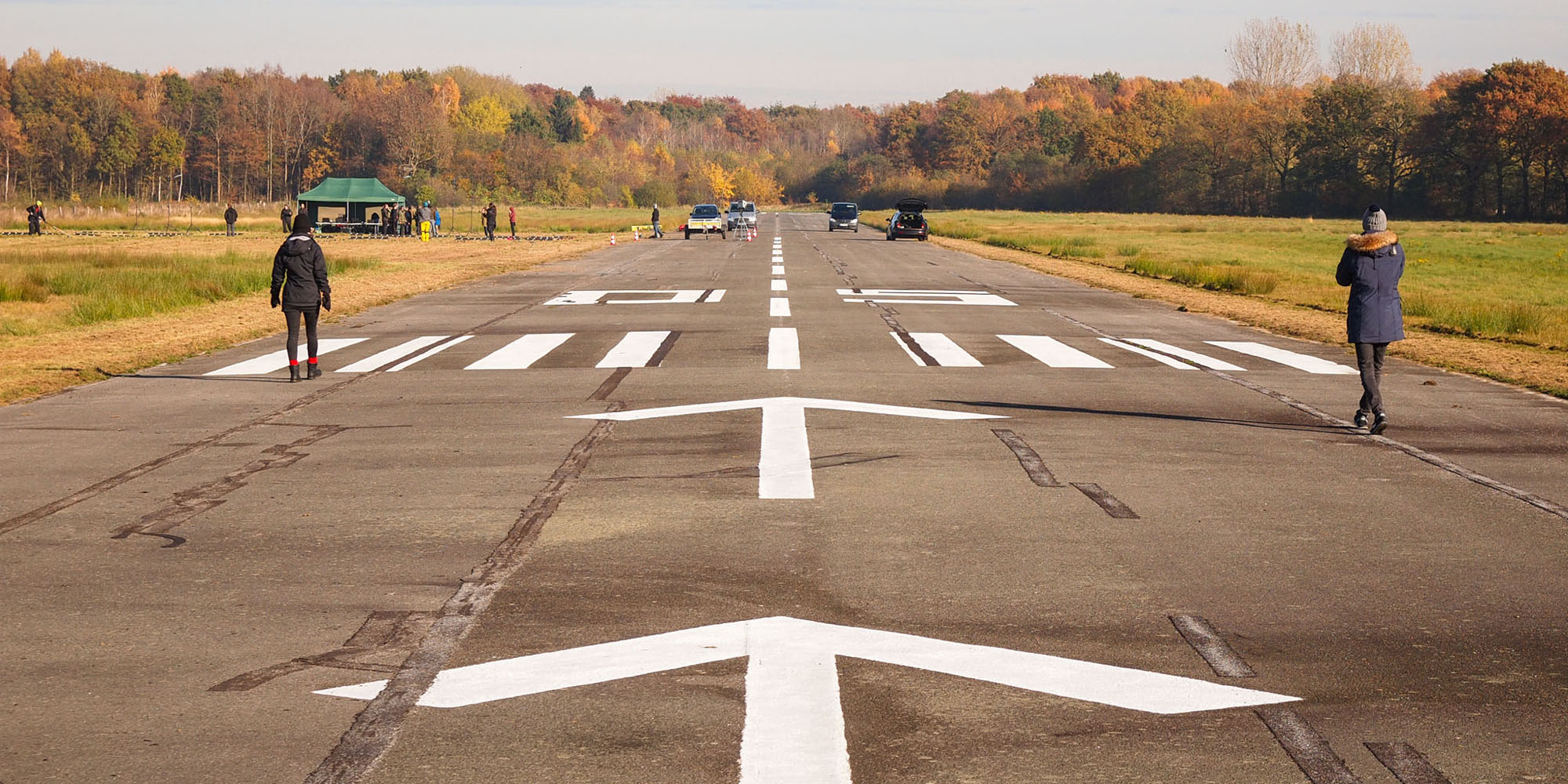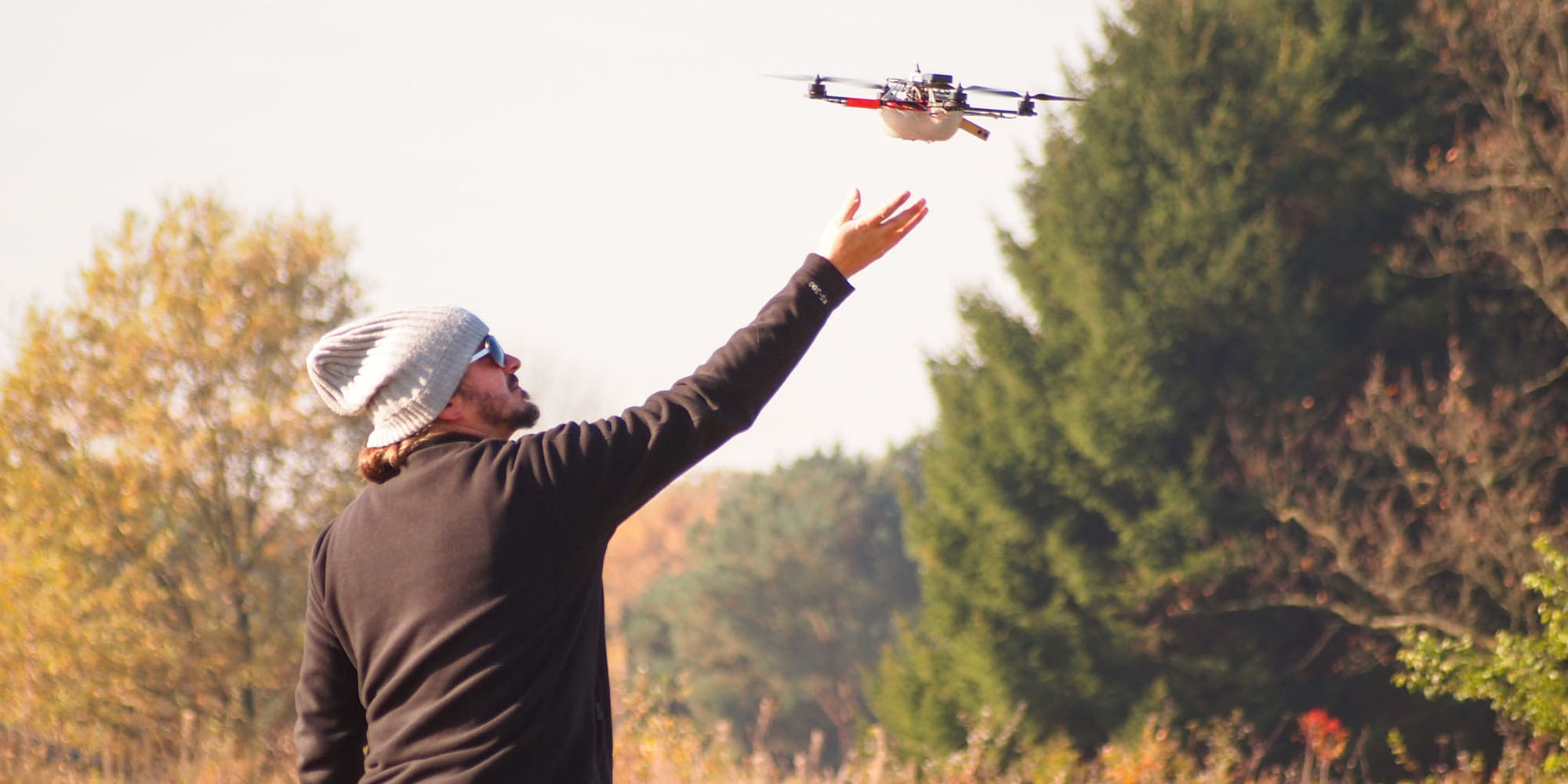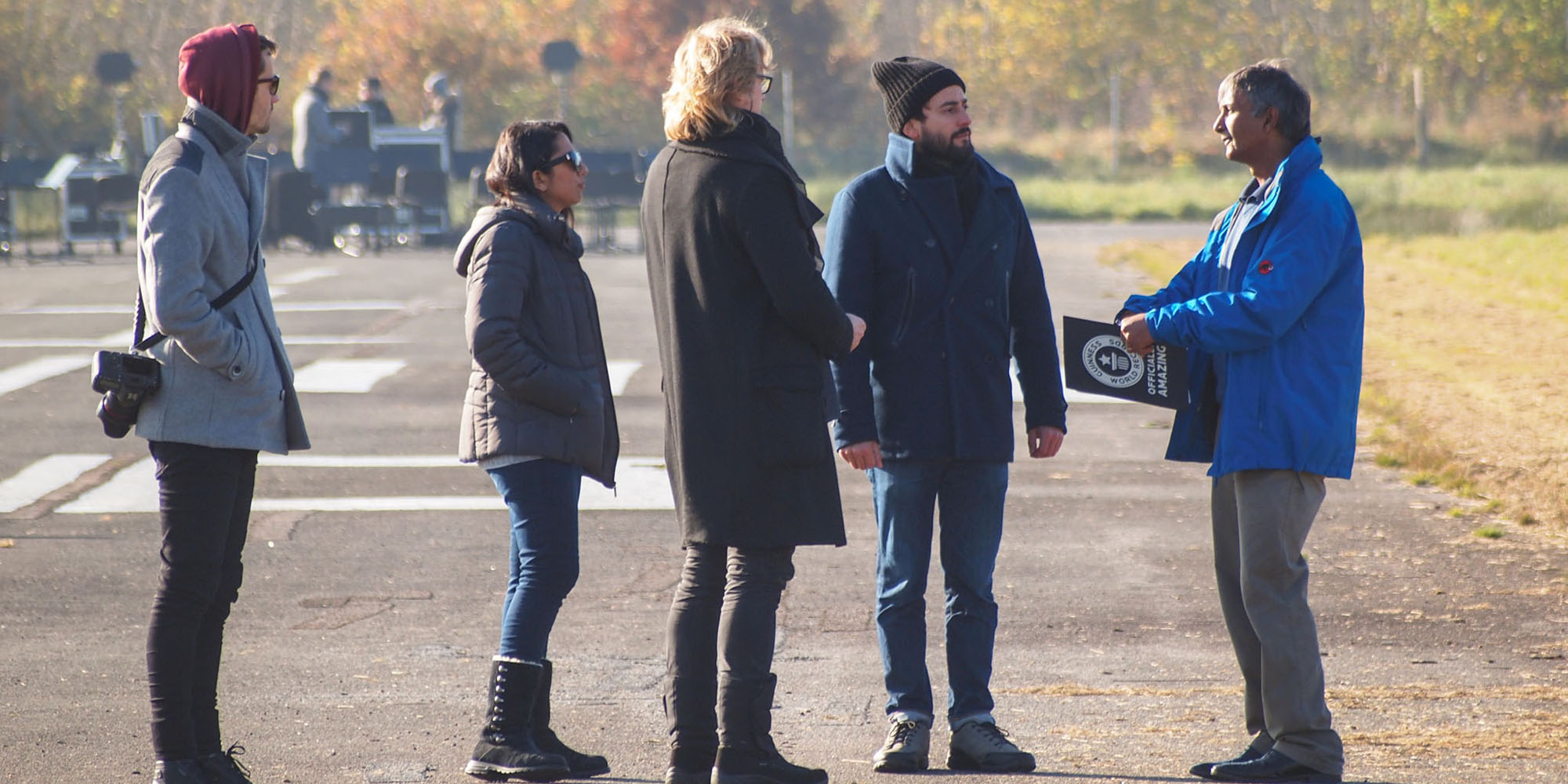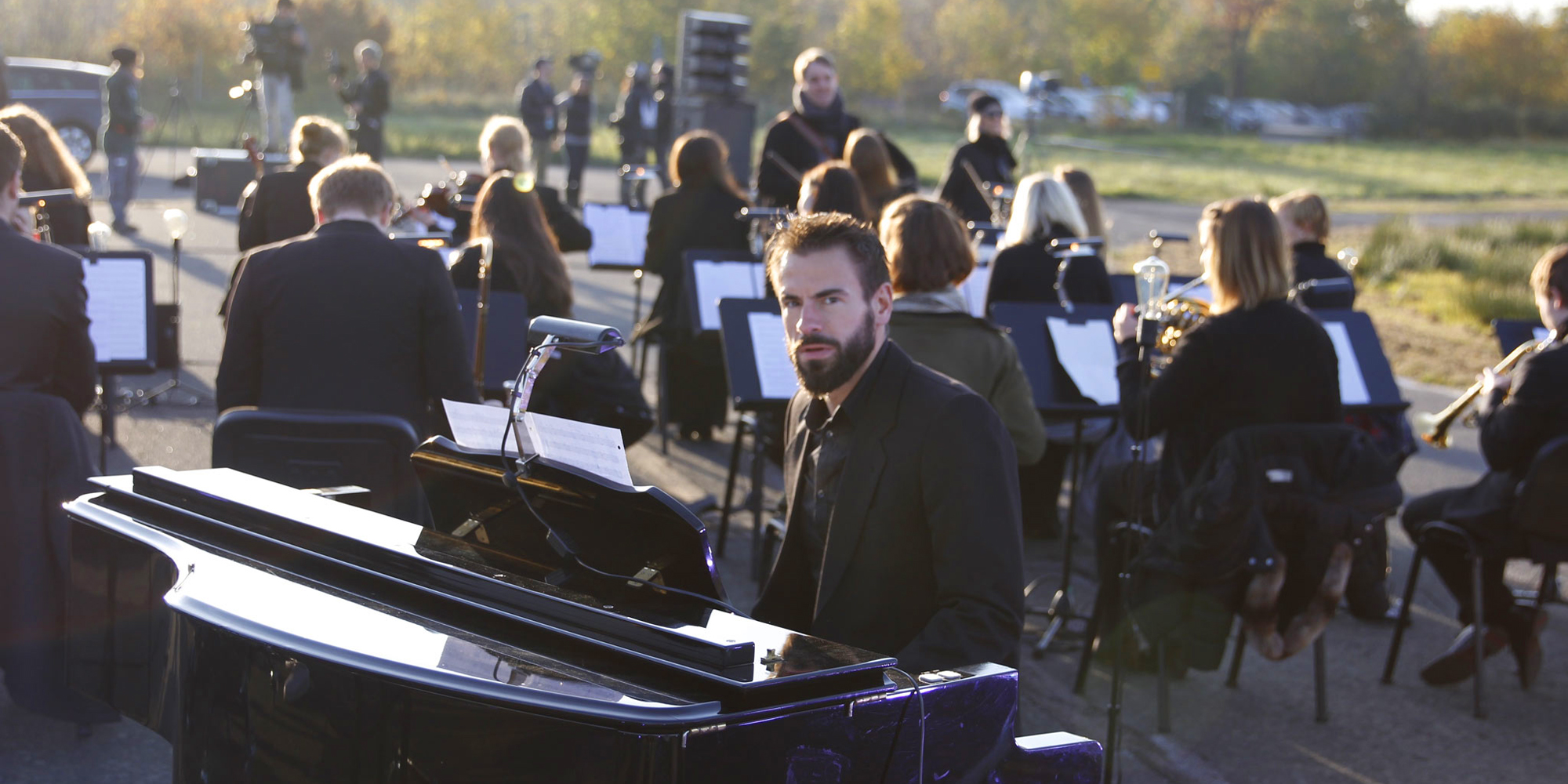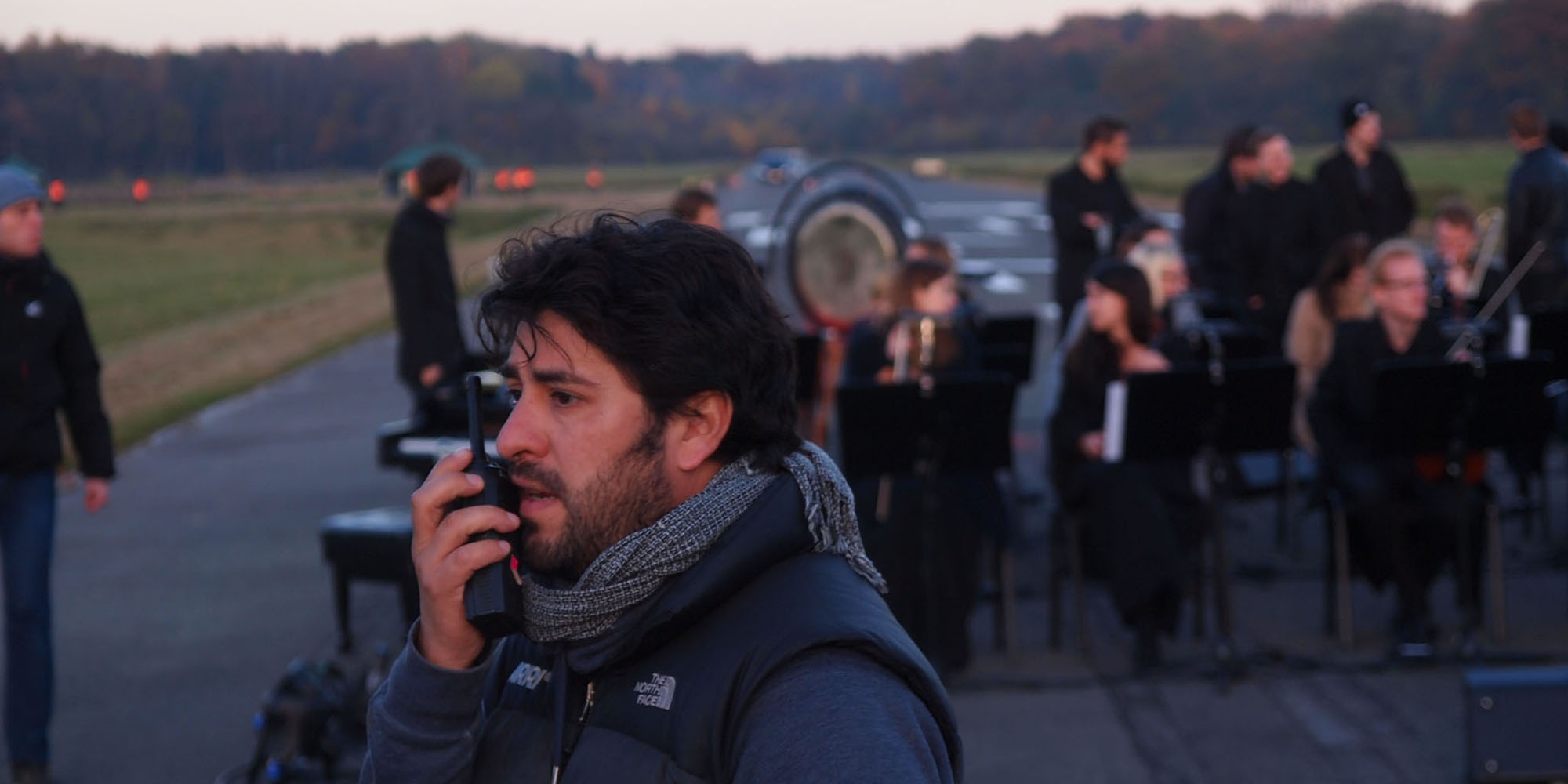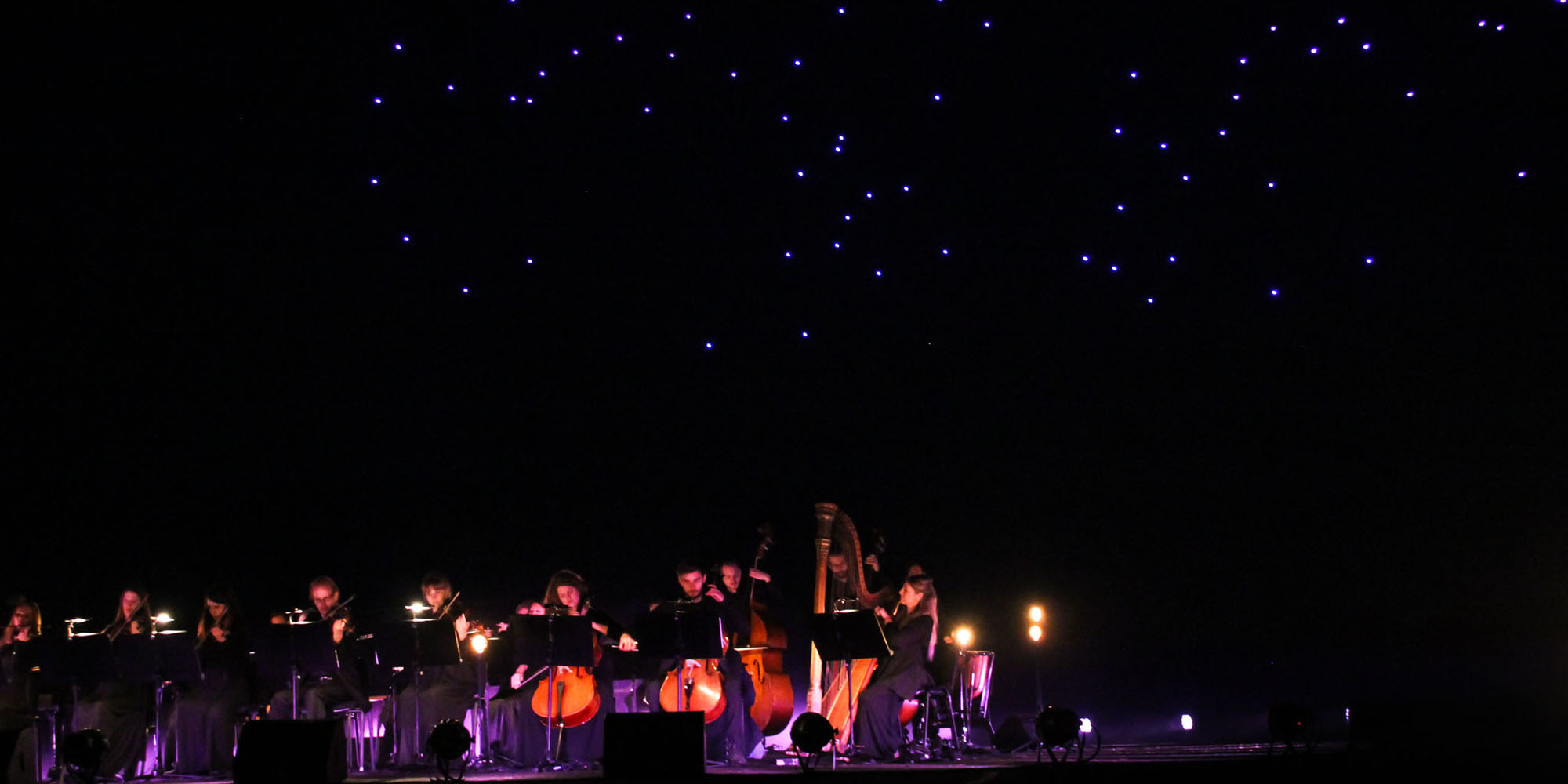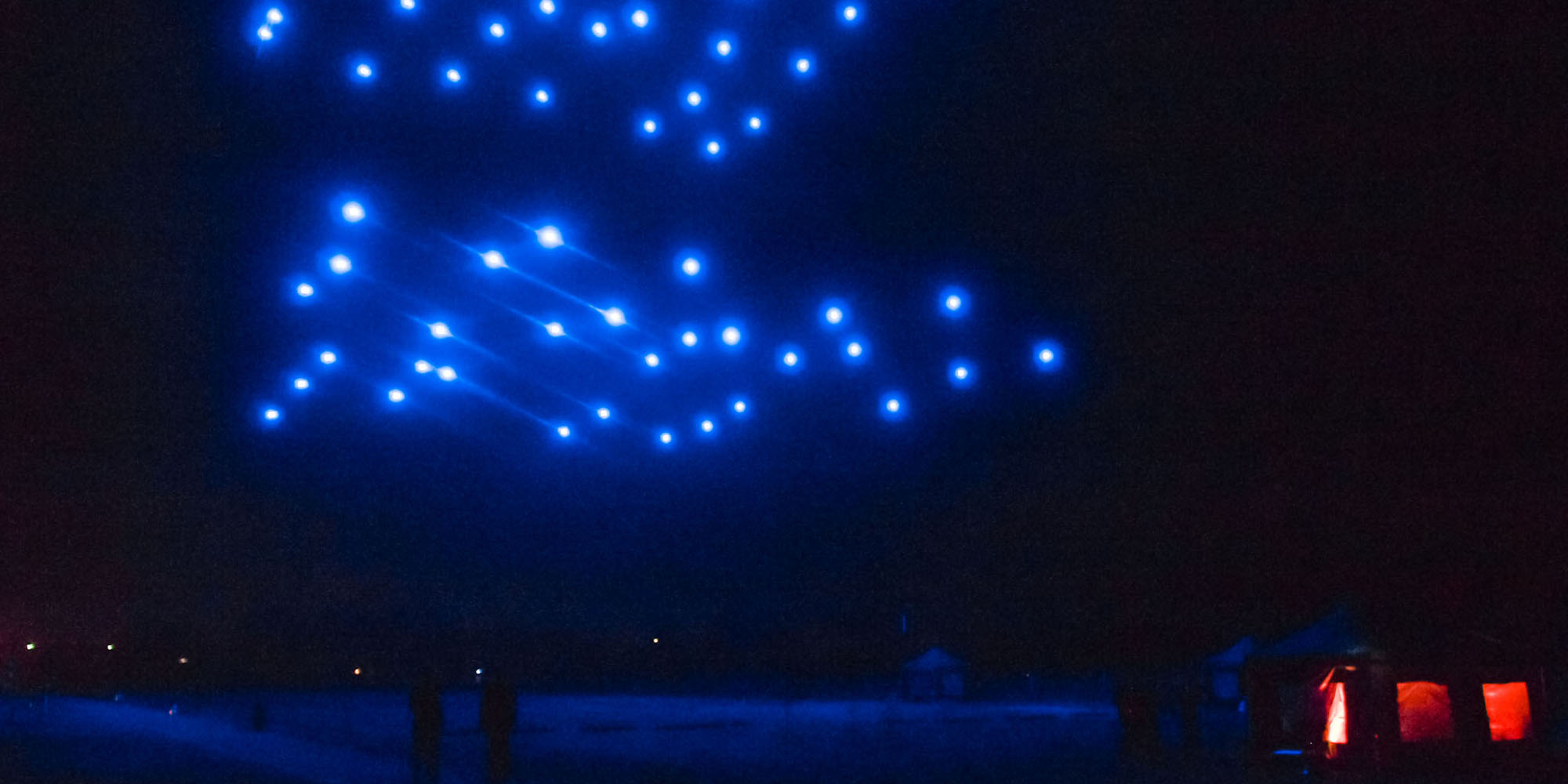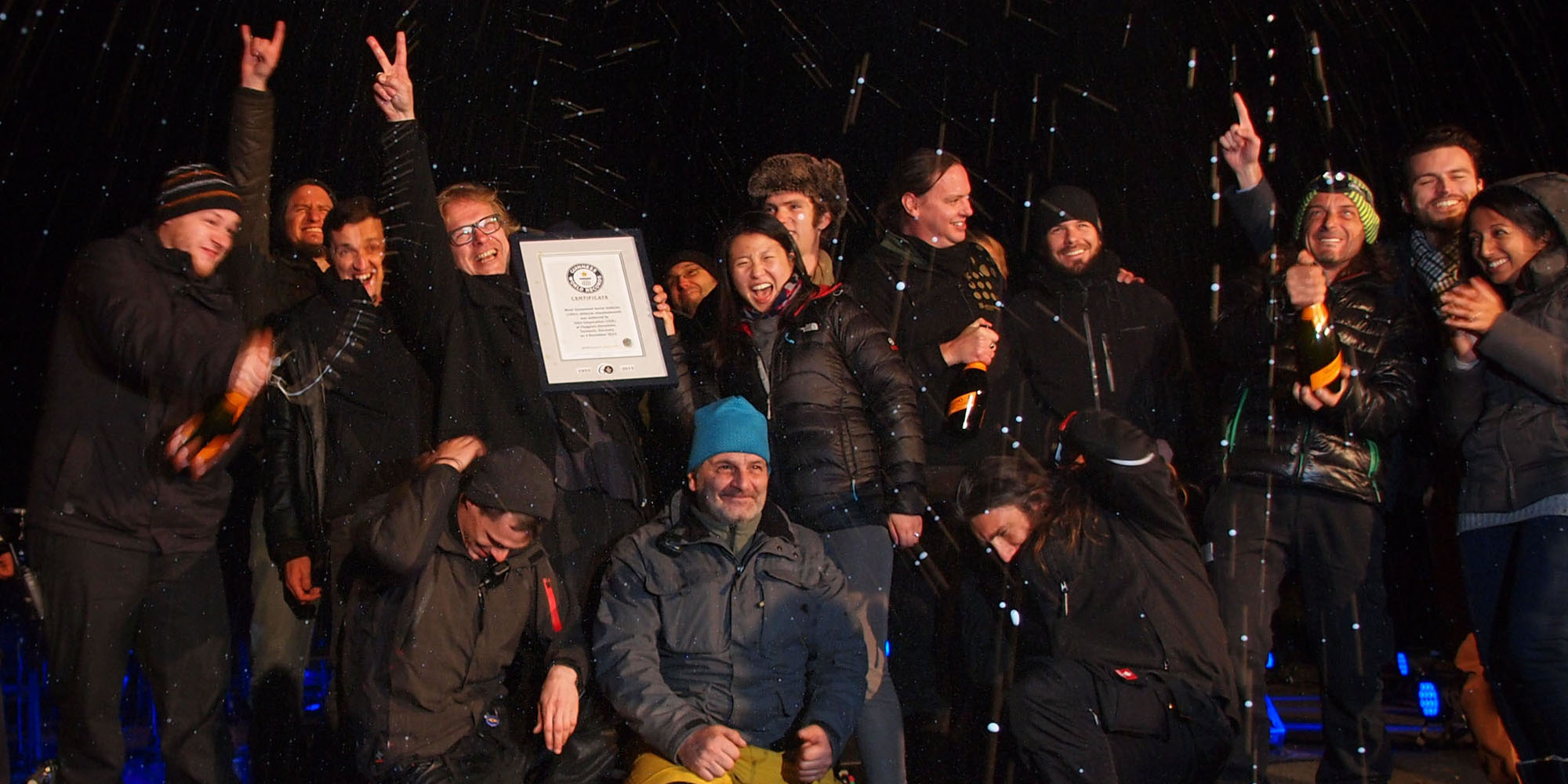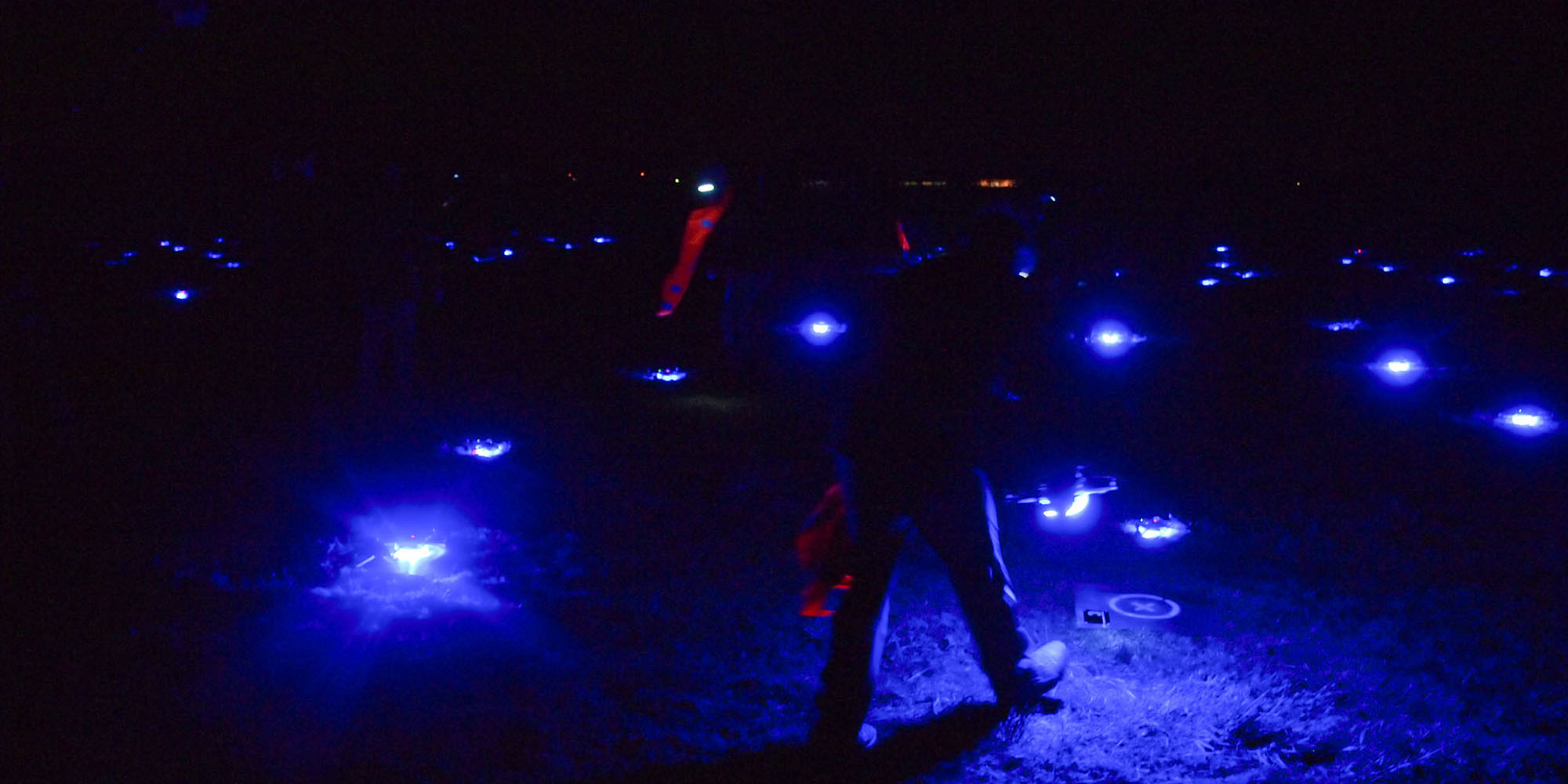The arrival of the Spaxels crew at Ahrenlohe Airfield in Tornesch near Hamburg, Germany brought these Ars Electronica Futurelab staffers to the culmination of a full year’s R&D work commissioned by Intel. Their mission: To surpass the previous record of 50 LED-studded quadrocopters aloft at once. The scenario of this performance spotlighting the world-famous chip manufacturer called for a squadron of no fewer than 100 illuminated drones ascending skyward to the sound composed especially for the occasion.
Horst Hörtner, senior director of the Ars Electronica Futurelab and inventor of the spaxel, on the tarmac at Tornesch. Photo: Martin Hieslmair
Taking formation size to the next level—doubling the number of spaxels in one fell swoop—was cause for considerable hustle & bustle on the set. After all, pulling off this Intel assignment would land the operation in the Guinness World Records. And it was all happening at the focal point of a professional film crew, which had already been capturing the test flights conducted a few days before on a proving ground at Ascending Technologies in Krailling near Munich. Despite the A-OK at the bottom line of that full-dress rehearsal, the team headed by Chris Bruckmayr was all too well aware that external influences—above all, the weather—could negatively impact the flight no matter how well it had been planned. For instance, the dense fog that had prevented the final test flight in Bavarian airspace. But the weather gods smiled down on this day and granted perfect flying weather for the world-record attempt.
The flight controllers of the spaxels crew—(from L to R) Andreas Jalsovec, Benjamin Olsen, Florian Berger, Martin Mörth—sent each copter aloft for a test flight. Photo: Martin Hieslmair
Whether the testing is done individually or in flights of 25 or 50, the preparations call for an all-out joint effort: (from L to R) flight engineers Gordan “Gogo” Mati, Brunon Drewinak and flight controller Florian Berger. Photo: Martin Hieslmair
The watchwords of the work leading up to the evening extravaganza were precise timing and coordinated deployment. Even the relatively high degree of anticipation on the part of every person present did nothing to diminish the team spirit that was all-pervasive. Each individual “space pixel”—hence the portmanteau word spaxel—was equipped by the crew with a fully charged battery and positioned at its designated takeoff & landing spot. Thus, its performance was thoroughly assessed prior to the swarm flight, as is standard operating procedure before every spaxels show.
The runway at Ahrenlohe Airfield in Schleswig-Holstein, where a Copter College is also held occasionally. Photo: Martin Hieslmair
Why is Intel actually so interested in unmanned aerial vehicles (UAVs) and collaboration with the Ars Electronica Futurelab? Anil Nanduri, General Manager of New Markets, Perceptual Computing at Intel, took time from his busy schedule for a brief chat:
“There is so much potential in the future with Unmanned Aerial Vehicles. Intel is passionate about the opportunities these UAVs bring, such as inspection, photo and videography, agriculture and lots more. There is a part of creativity – being able to see these as a form of light shows in the sky – that is an intricate balance between technology and art. ARS Electronica Futurelab shares that vision and is a great partner in helping realize that with us, we can push the boundaries of technology, art and creativity as we did with Drone 100.”
Flight engineer David Haider’s unit was assigned to prevent the drones from landing in damp grass. Photo: Martin Hieslmair
So, for Intel this is a lot more than a colorful show in the night sky? Kinnari Desai, Intel Integrated Brand Campaigns, was on site:
“There are already explorations around the delivery of packages and of life-saving supplies to a deserted area. The ability that this piece of technology has to offer – to go to places we can’t go as humans – is endless and unfathomable right now.”
Initial talks elaborating on the day’s sequence of events among Kinnari Desai (Intel – Integrated Brand Campaigns, 2nd from L), Horst Hörtner (Ars Electronica Futurelab – senior director, middle), Sergio Abuja Rodriguez (film director, 2nd from R), Jens Koch (still photography, L) and Pravin Patel (Guinness World Records, R). Photo: Martin Hieslmair
Wednesday, November 4, 2015. Around Noon, Pravin Patel, Guinness World Records‘ representative and official referee, arrived at the airfield and triggered a quantum leap in the crew’s awareness of precisely what they were here to accomplish. If everything went as planned, this high-profile spectacle would simultaneously launch a brand-new world-record category: “Most Unmanned Aerial Vehicles (UAVs) Airborne Simultaneously.”
Futurelab Senior Director Horst Hörtner displays confident determination during a take by the film crew (From L to R: director Sergio Abuja Rodriguez, director of photography Andres Lizana Prado, assistant cameraman Christoph Kunze and sound engineer Kris Limbach). Photo: Martin Hieslmair
This sunny autumn day provided ideal conditions for a successful event, and all participants were highly motivated and well prepared. Over the course of the test flights, the members of the spaxels crew and the film unit had developed a great deal of mutual respect and enthusiasm for the work their counterparts were doing, so the prevailing mood was that of a pleasant reunion.

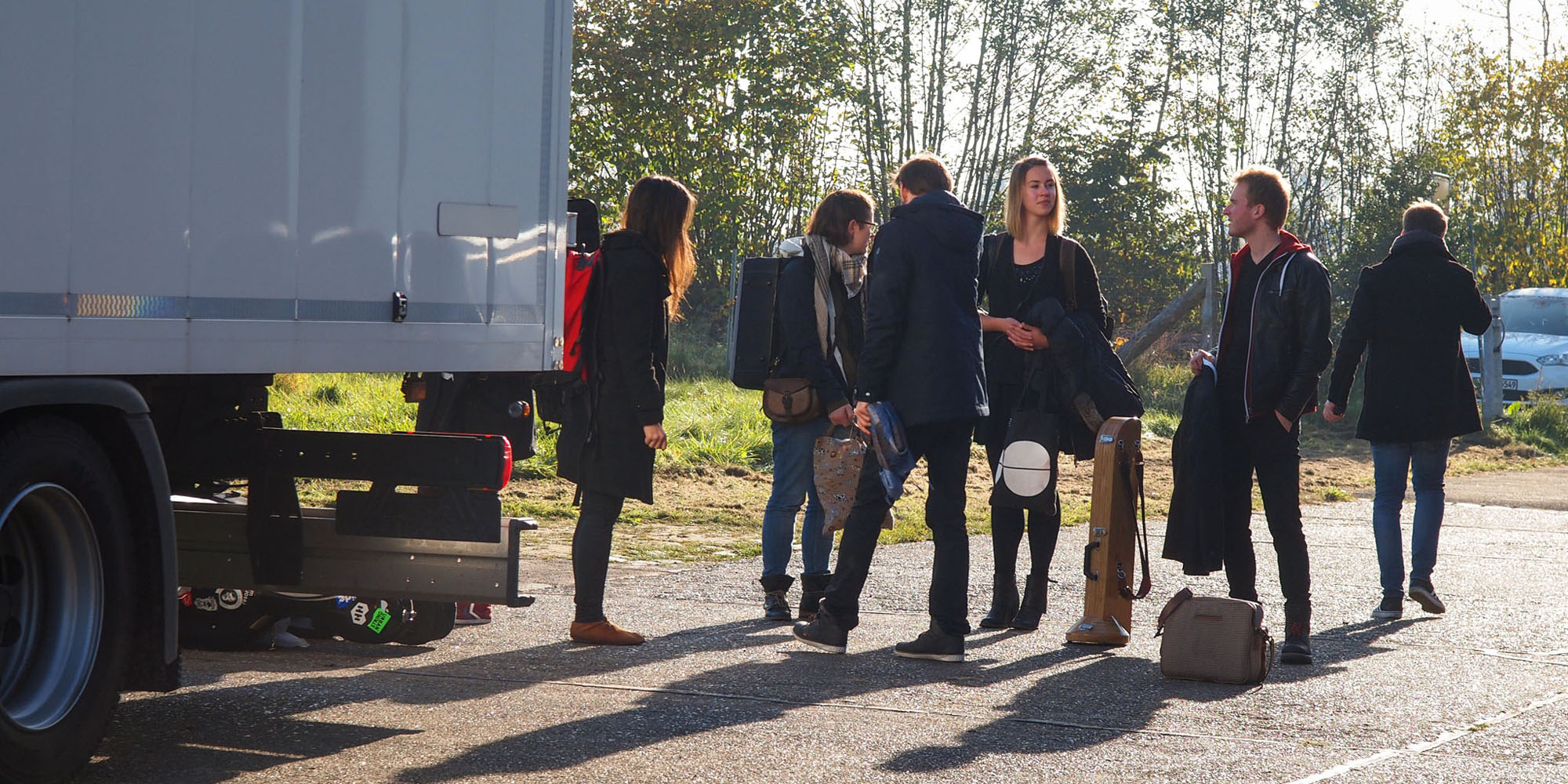
Left: Scrutinizing the setup design that had been conceived by the spaxels crew. Right: A steady stream of protagonists showed up. Scheduled takeoff of the spaxels flight was 5:45 PM. Photos: Martin Hieslmair
Members of the 25-piece orchestra arrived in the afternoon and set up their instruments on the runway. They all had in common was their shared enthusiasm about being part of an event, the likes of which none of them had ever experienced before. So film director Sergio Abuja Rodriguez sure didn’t have to go to great lengths to get everybody onto the same page and into the swing of things.
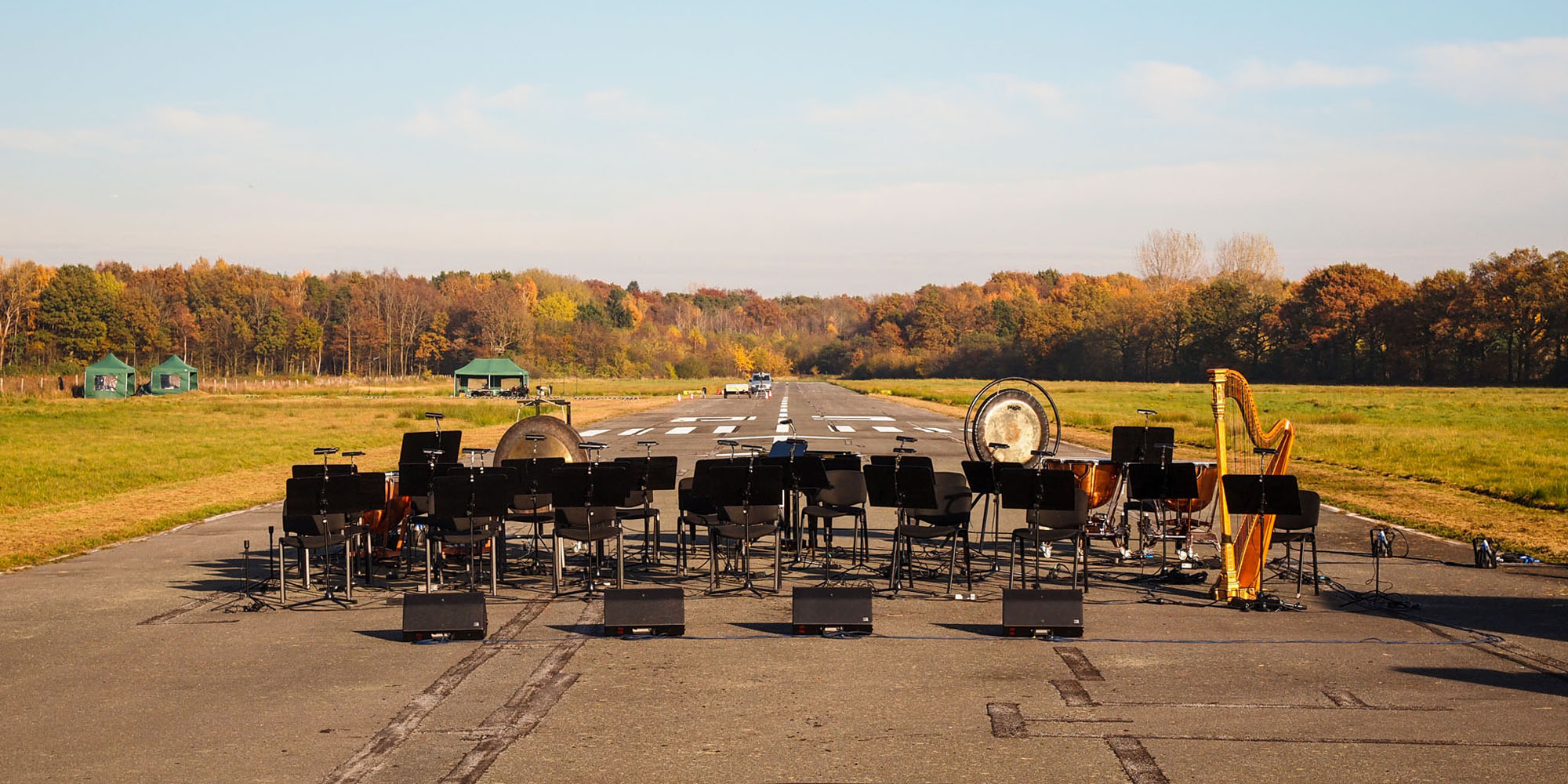

A series of briefings acquainted the musicians, camera crew members and technicians with the details of the roles they would be playing this evening. Photo: Martin Hieslmair
The orchestra members received precise instructions as to their parts and gestures. Their personal pride and sense of professionalism was quickly evident all around, enhanced by the fascinating prospect of taking part in such an out-of-the-ordinary world record. The film crew got their cameras positioned while there was still daylight, above all in coordination with the spaxels show design that had been choreographed weeks before and tested virtually for this site.


Director Sergio Abuja during conversations with the spaxels team, the film crew and the orchestra. Photos: Markus Scholl, Martin Hieslmair
Horst Hörtner sketches the vision that’s motivated him and his crew since early 2012 in these terms:
“After all, who says that a formation of 100 drones can’t fly in unison? And who says that it won’t be possible in a few years to construct spaxels that actually are the size of a computer monitor’s pixel today? And assuming that that’s the case—who would prefer to sit in front of a flat screen if they can go out and see three-dimensional images and interact with them?”


Photos: Martin Hieslmair
The afternoon sun provided enough light for a final check of the spaxels’ takeoff conditions together with Pravin Patel of Guinness World Records and an independent eyewitness. What a feeling that must be, dealing with a different world record every week?!
Pravin Patel: „It’s brilliant because every record is different. One minute you are watching a person swimming in the Indian Ocean with his hands tied and in the next minute you are watching a car breaking on ice in Canada and today watching 100 UAVs flying simultaneously in the air. Every record is different, every world record is very exciting.”
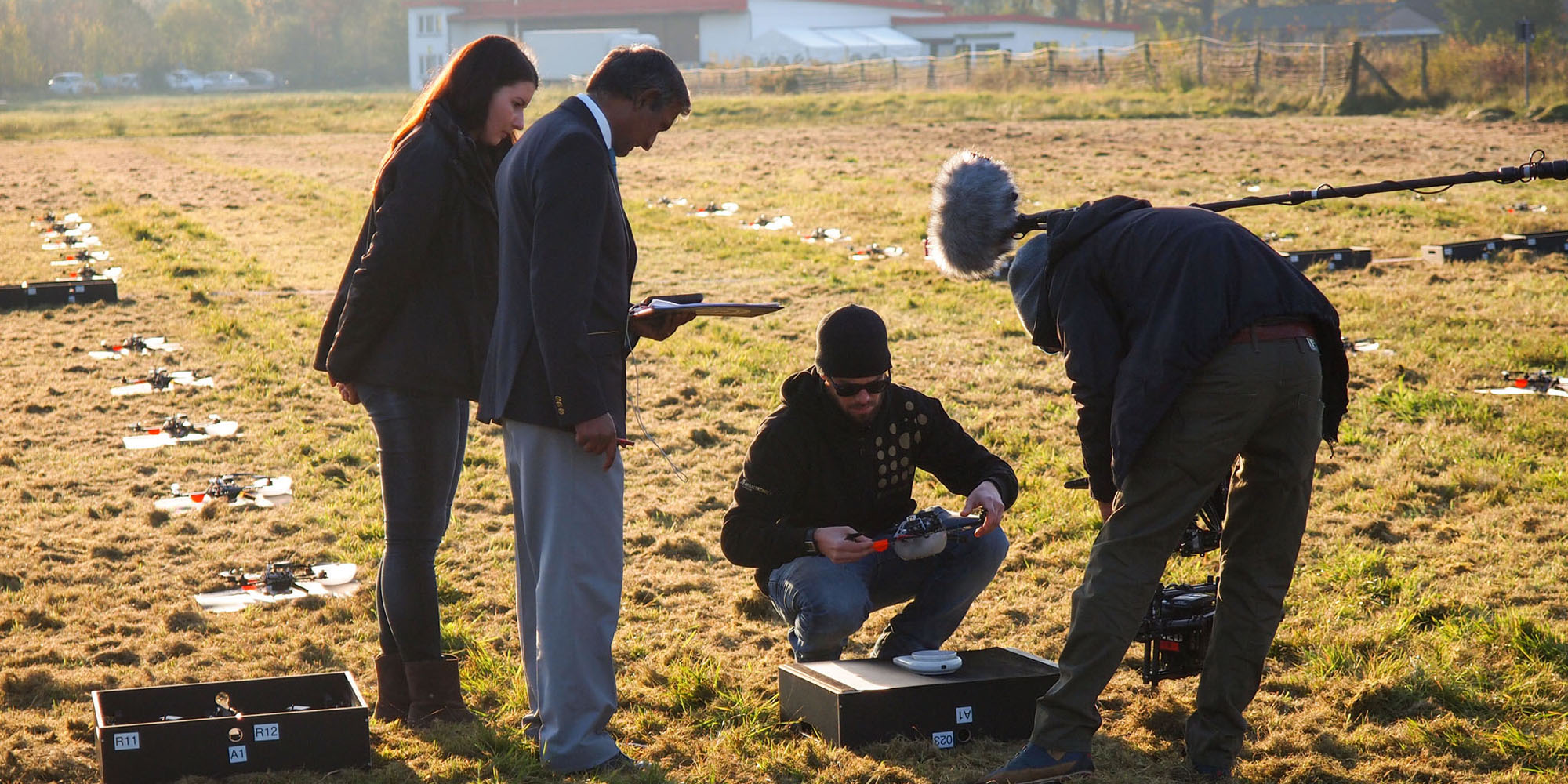
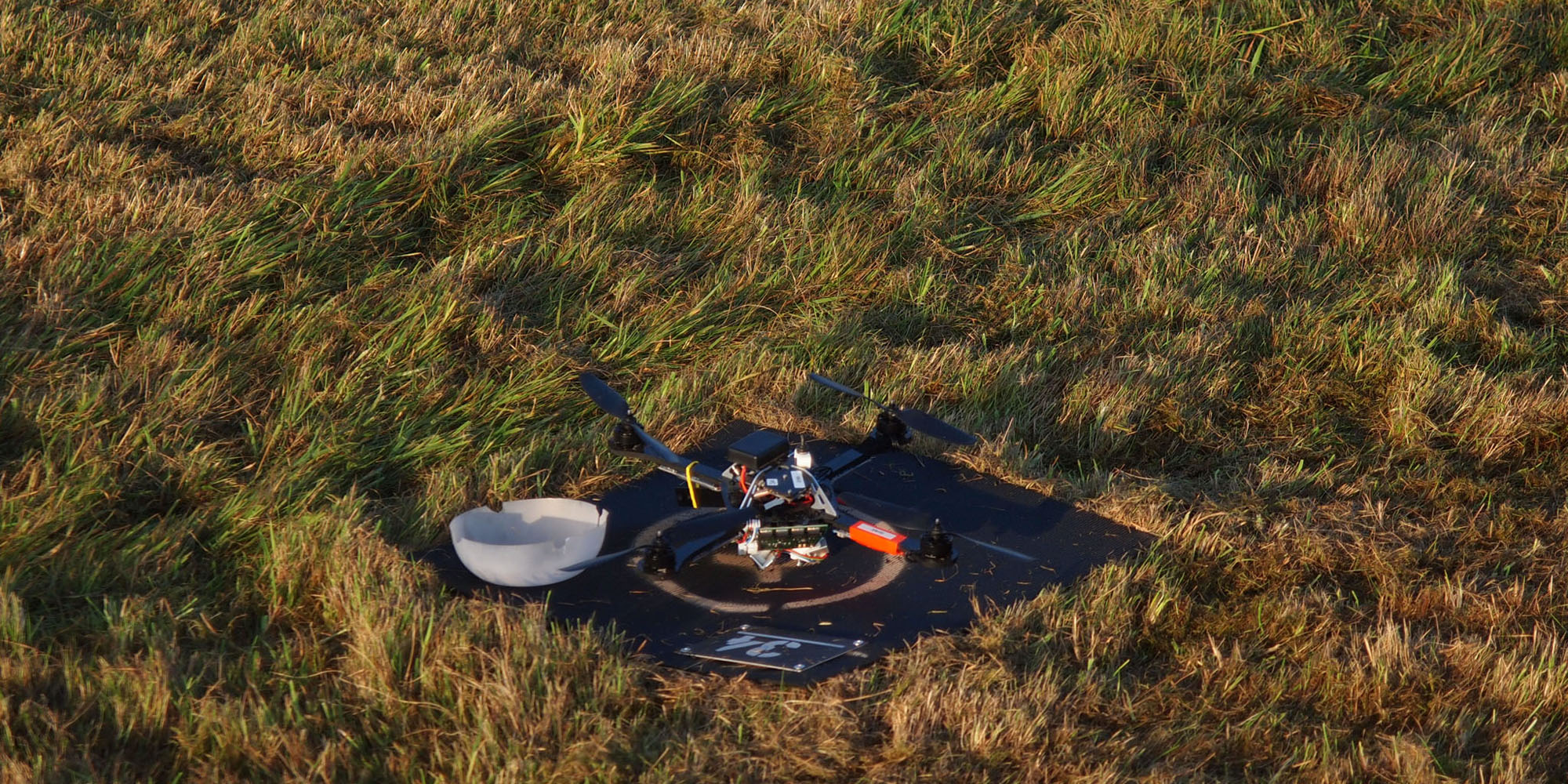
Guinness World Records’ representative Pravin Patel inspects the spaxels. Photos: Martin Hieslmair
The conditions on this day were outstanding; you couldn’t have asked for better weather—hardly any wind, no rain at all, a cloudless sky no less! The spaxels had successfully faced extreme weather conditions in Dubai, UAE, in Umea, Sweden and even at their 2012 debut at the voestalpine Klangwolke in Linz.

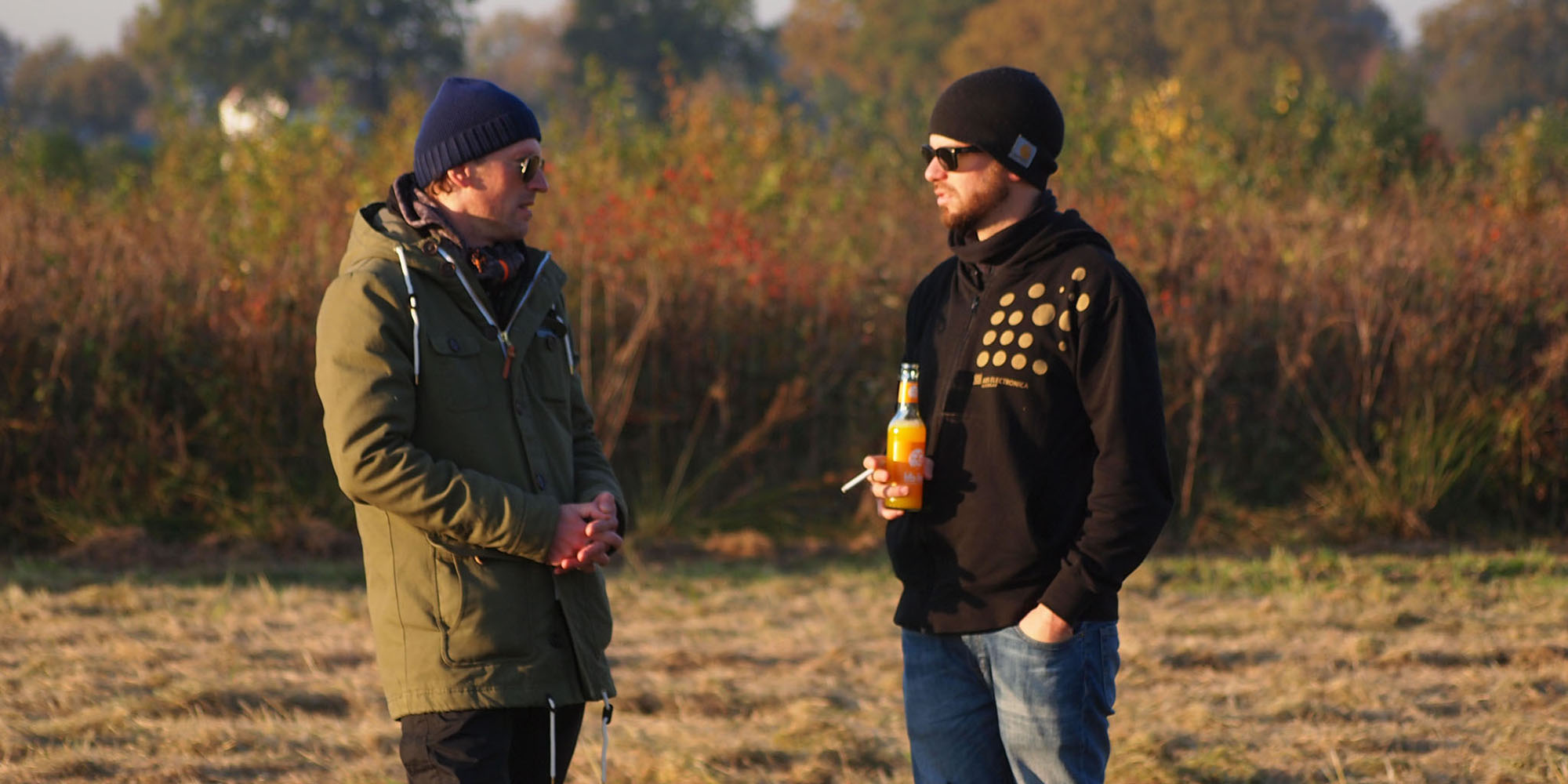
Final preparations in the staging area accommodating 100 spaxels. Left: The clipboard emblazoned with the Guinness World Records slogan. Right: Spaxels producer Chris Bruckmayr in conference with flight engineer supervisor Michael Platz. Photos: Martin Hieslmair
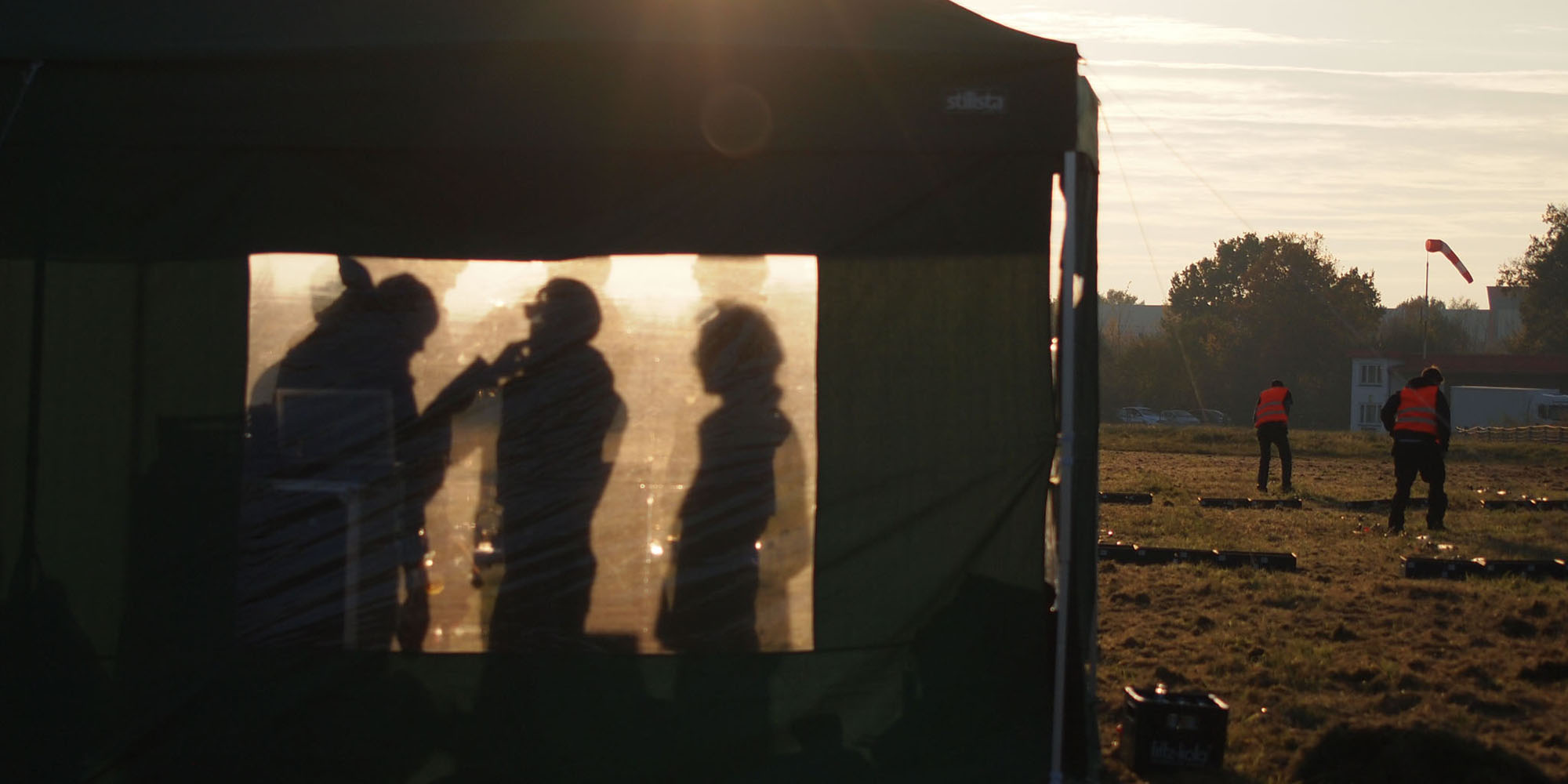

While the flight controllers were discussing technical details in the headquarters tent, the flight engineers were checking the quadrocopters one last time as the sun slowly set. Photos: Martin Hieslmair
This was the first time that Guinness World Record staged an attempt in this category and, above all, in these dimensions. Pravin Patel noted:
“That’s right! This is the first time. It’s a brand new world record, that hasn’t been recorded before. We don’t say, ok, turn up with 10 UAVs and do it. We always say that this is a world record with a challenging target. This time the challenging target was one hundred.”
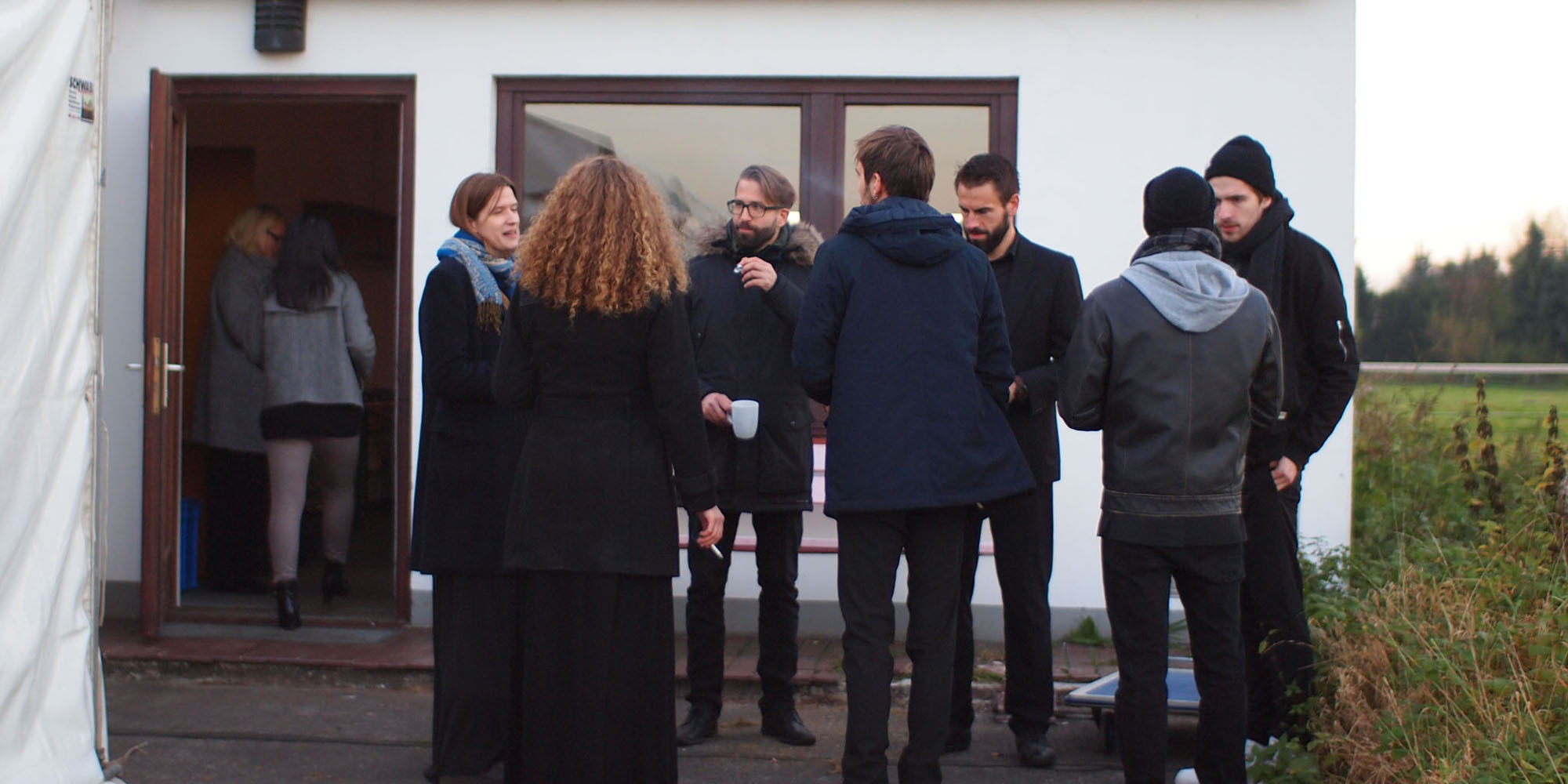
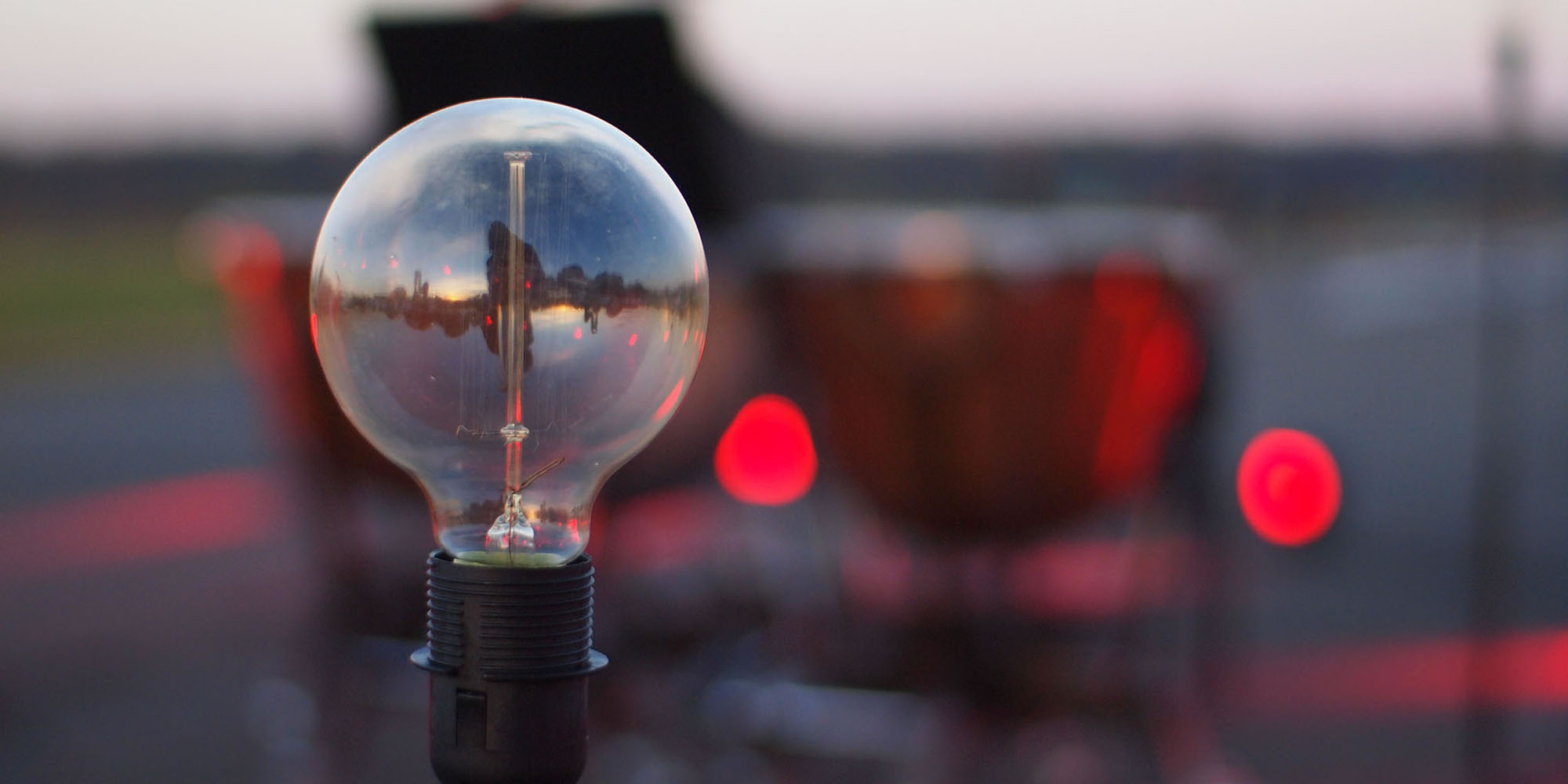
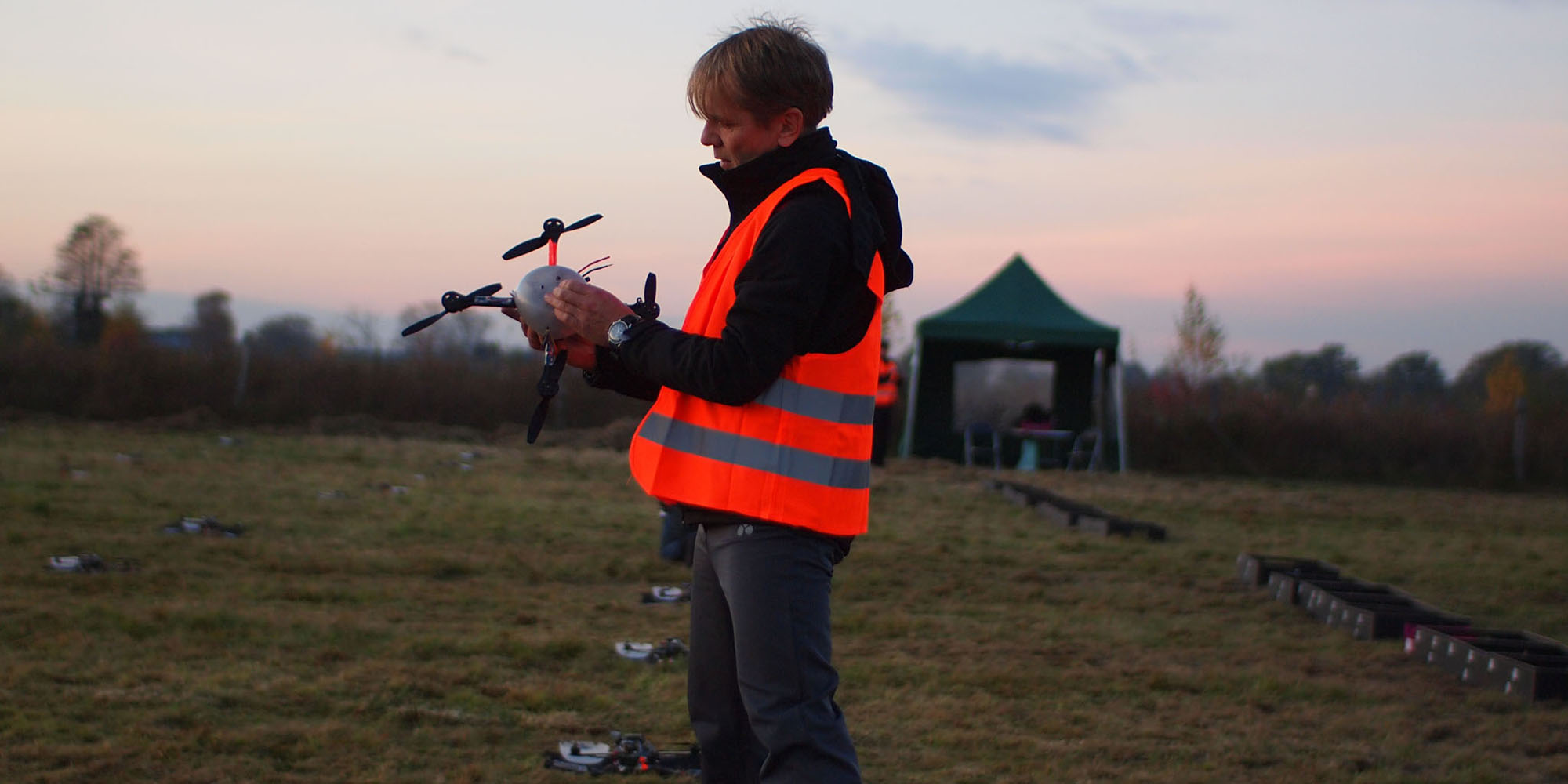
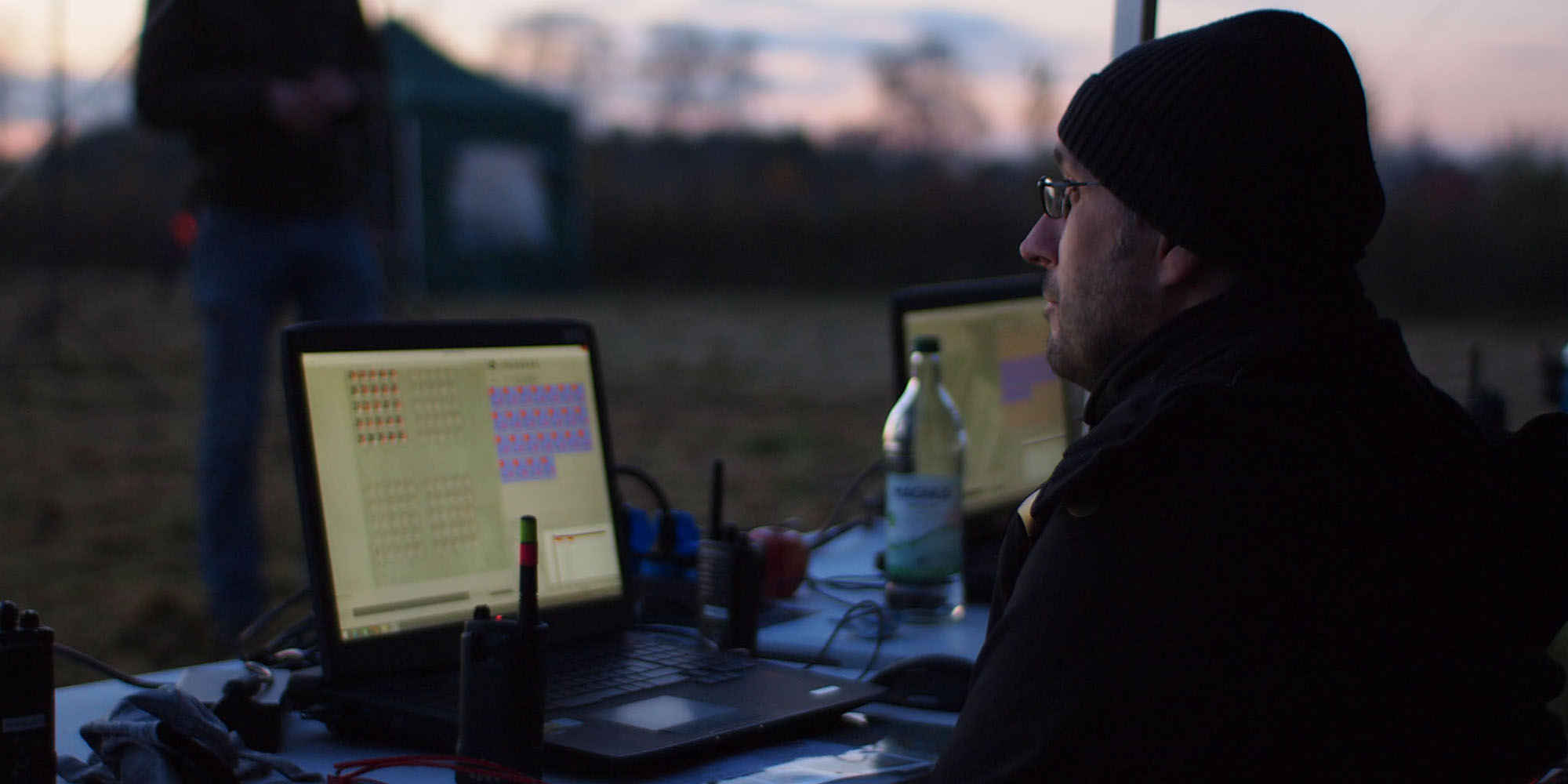
As the sun went down, the tension rose all around. Left: Flight engineer Alois Luis Wohlmuther performs final preflight checkups. Right: Flight controller Florian Berger concentrates on take-off preparations. Photos: Martin Hieslmair
The later it got, the more concentrated the interaction among the individual units became. The orchestra and the spaxels crew were positioned hundreds of meters apart on this evening. To compensate for a delay between the video and the audio, the length of the runway was bridged via walkie-talkie command. Shortly before, a few final rehearsals by the orchestra had smoothed out the last few discrepancies to accompanying the perfect timing that is the core of a drone 100 visualization. Between the various run-throughs and the moment of the world record attempt, the spectators who would serve as the audience in the documentary arrived. The musicians passed the time by warming up, rehearsing particular sequences, and exchanging anecdotes, while the film crew and the spaxels team went through their respective check lists.
Loud and clear: Director of photography Andres Lizana Prado communicated with his unit and the spaxels team via walkie-talkie. Photos: Martin Hieslmair

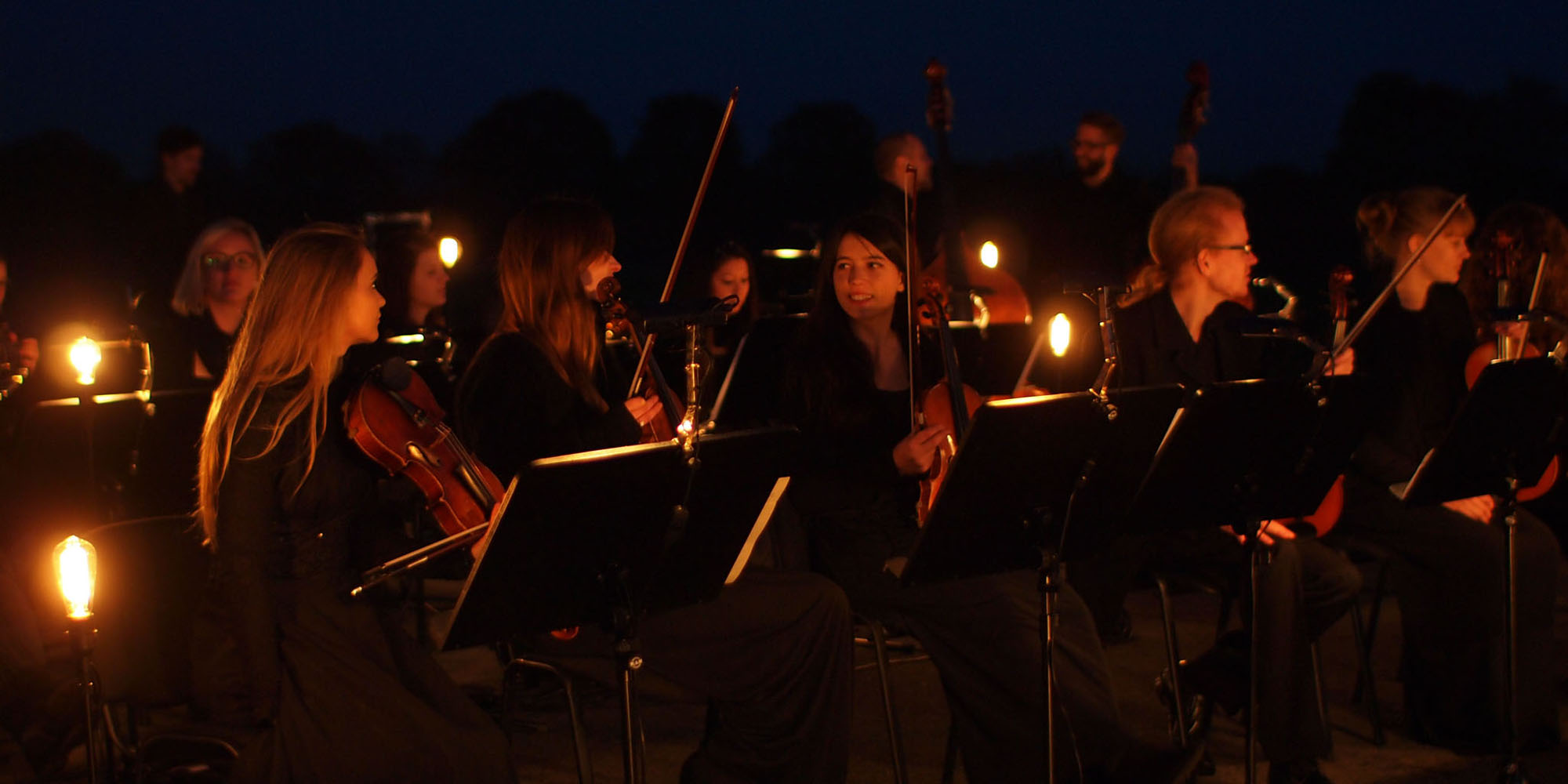
5:30 PM. Only 15 minutes to showtime. Photos: Martin Hieslmair
The red gleam of the spotlights bathed the runway with a dramatic hue. Then it was launch time: the countdown sounded from the other end of the runway and, when the sequence reached 4, a timpani roll announced the liftoff of 100 illuminated quadrocopters.
Only some seconds are left until the coordinated ascent of 100 spaxels – reaching an altitude of about 120 meters. Photo: Intel Corporation
Following this crescendo, the points of light took off into the evening sky. A few measures later, the musicians’ performance resounded at full strength.
Spaxels in the night sky: three-dimensional figures, far brighter than Sirius. Photo: Intel Corporation
A fascinating illuminated spectacle, unprecedented in this form. Photo: Martin Hieslmair
The double array of spaxels and the smooth intermeshing of the respective aerial formations impressed not only those who had never witnessed a performance of this kind before. The image shifts done precisely in time to the music enthralled the entire entourage.
Starry, starry night above Tornesch near Hamburg on November 4, 2015. Photos: Martin Hieslmair
The excitement climaxed in tempestuous applause that broke out with the appearance of the Intel logo.
After more than seven minutes their show was completed, the spaxels returned to their departure position. Photo: Martin Hieslmair

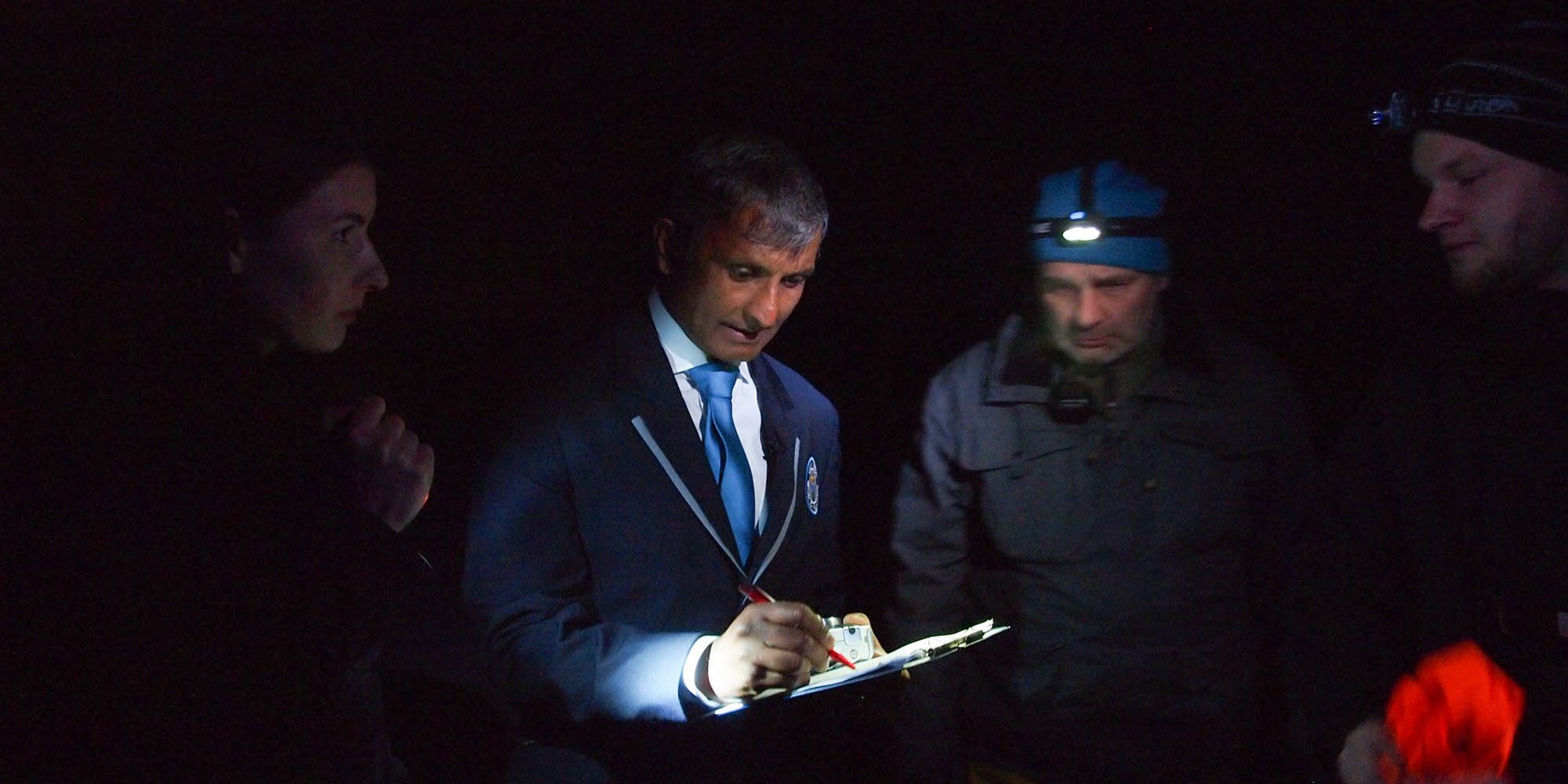
Guinness World Records supervisor Pravin Patel officially records the world record before the eyes of independent witness Ira Hoffmann and flight engineers Walter Rauchegger and Simon Kopfberger. Photos: Martin Hieslmair
The world record was in the books, the film footage in the can, and all doubts about how this would turn out had long since been dispelled. There were heart-felt embraces among the members of the Ars Electronica Futurelab’s spaxels crew as Guinness’ Pravin Patel officially announced the world record.
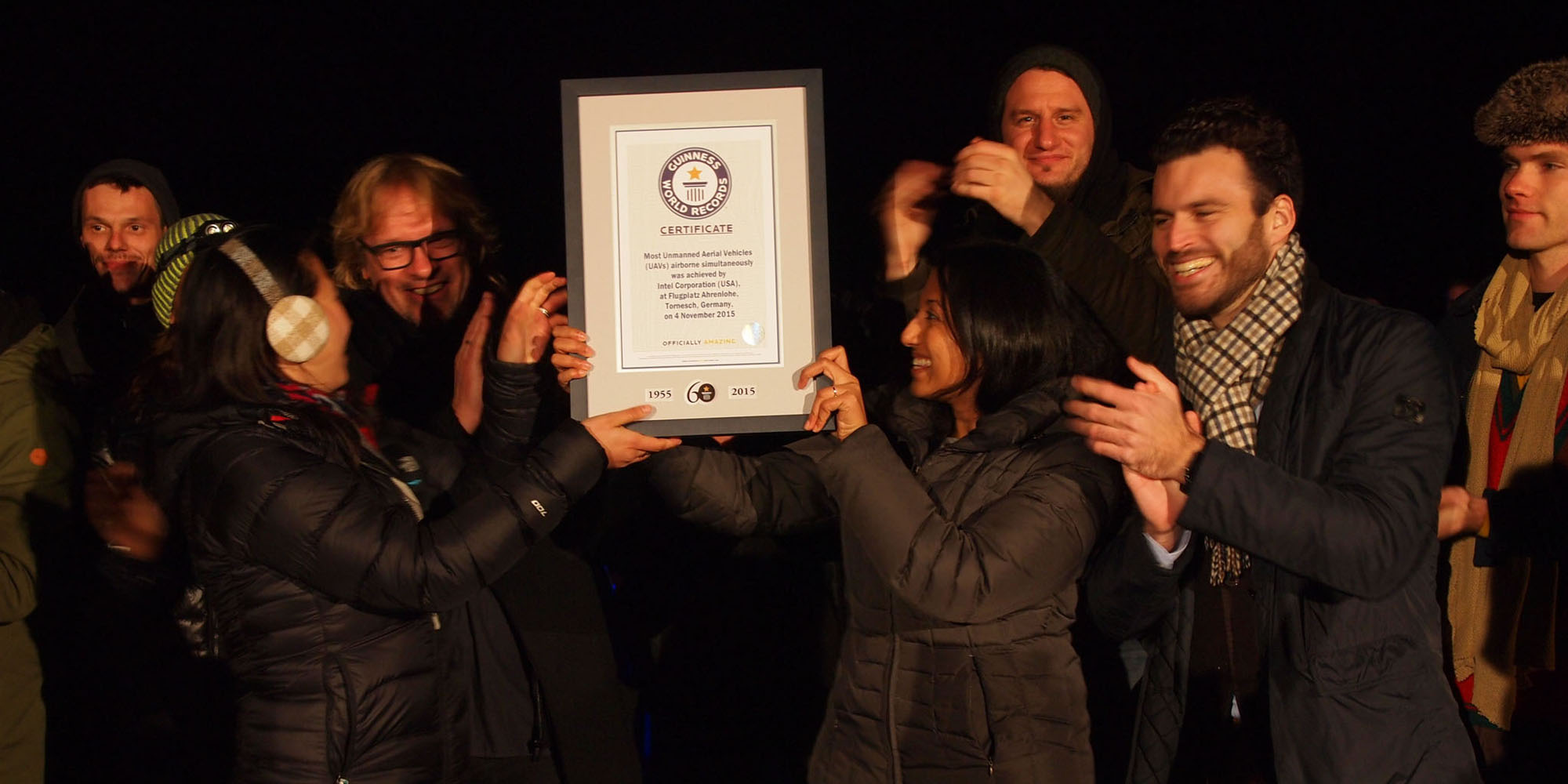

Recognition for great teamwork: 100 spaxels are aptly celebrated with popping champagne corks! Top: (from L to R) Back row: Simon Kopfberger, Martin Mörth, Andreas Jalsovec, Horst Hörtner, Florian Berger, Natalie Cheung (Intel), Ben Olson, Jonathan Rutherford, Michael Platz, Brunon Drewniak, Riccardo Masucci (Intel), Kinnari Desai (Intel); Front row: Samuel Eckl, Walter “Rasta” Rauchegger, Gordan “Gogo” Matic. Photos: Martin Hieslmair
Once the official certificate was bestowed, a brief champagne-cork-launching competition was held! There was pure joy on the faces of all those who had contributed to this successful endeavor. So what about the wrap-up of director Sergio Abuja, who’s been shooting promo films for such clients as MTV and Walmart for over 10 years now?
“Actually it was epic! This is one of the experience that I’m gonna remember for years and my entire life! For sure! These guys from Ars, like it or not, we are related till the end of the times! We lived this experience together. From the filming point of view, it was really good because we did a lot of rehearsals in Krailling. We knew what we needed to improve here in order to make it perfect. You know, I trust these guys. I’m with them for two weeks right now and I trust them 100 percent and now I’m very confident that you can go to work with them together.”
The conclusion of a successful day’s work. Photo: Martin Hieslmair
Horst Hörtner, director of the Ars Electronica Futurelab, summarized what was going through his head when the UAVs took off in pursuit of a world record:
“One rarely experiences moments in which it becomes crystal clear how important and rewarding it can be to defy all the naysayers, to steadfastly pursue a vision and to work unwaveringly for years to bring it to fruition. Everything had come together—an idea that was crazy in the best sense of the word, a crew that brought tremendous zeal and long-term commitment to the task, and, with Intel a partner who wanted to make the supposedly impossible a reality and went all out to achieve success.”
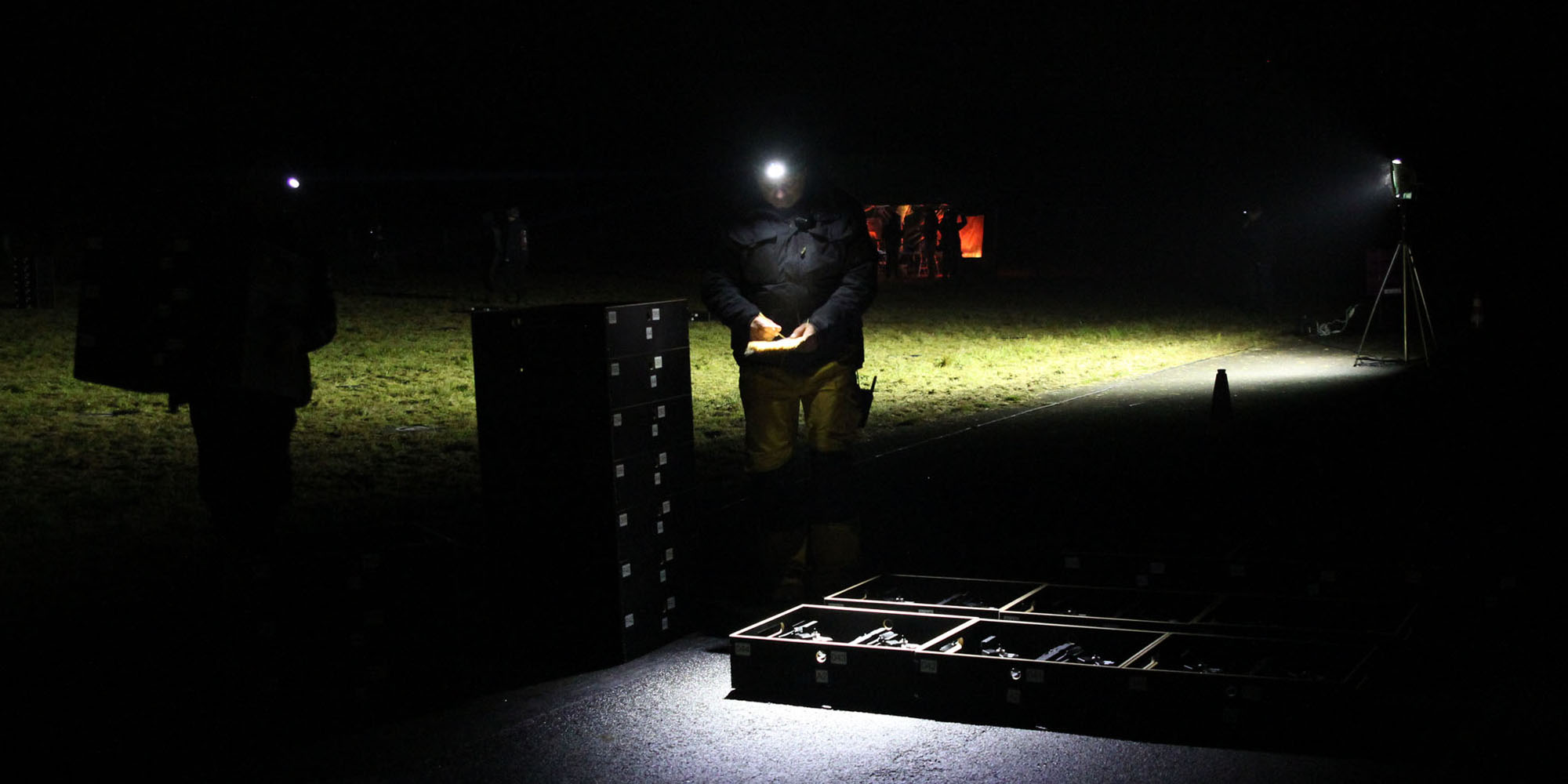
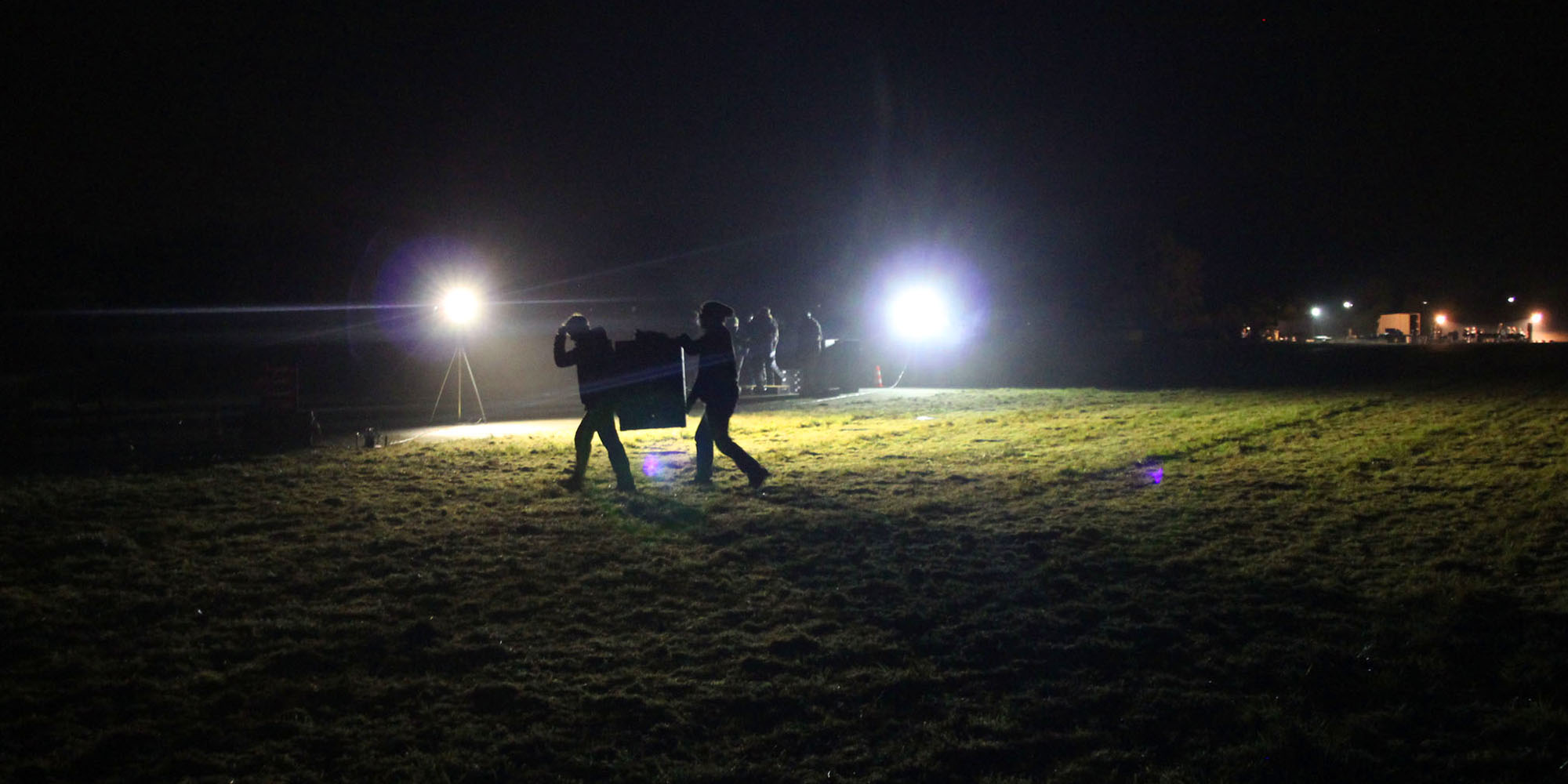
Text: Markus Scholl, Martin Hieslmair
Find out more about the Spaxels of the Ars Electronica Futurelab on ars.electronica.art/spaxels and don’t miss to have a look at the tech culture magazine IQ by Intel!

